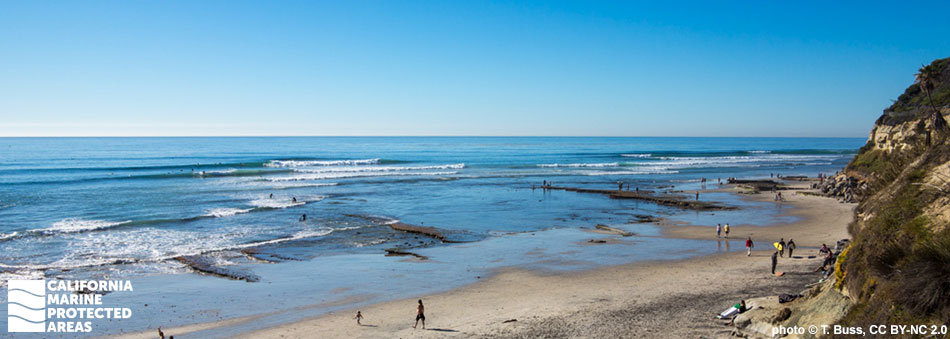
Overview
Swami’s State Marine Conservation Area (SMCA) is San Diego County’s largest marine protected area (MPA). Located 75 miles south of Los Angeles and offshore of Encinitas, California, the MPA is named after the world-famous surf spot, Swami’s. Swami’s SMCA covers almost 13 square miles of marine habitat, including miles of sandy beach, rocky intertidal areas, deepwater canyon habitat, coastal marshes, surfgrass beds, rocky reefs, and kelp forests. Swami’s SMCA protects large areas of surfgrass and kelp forest ecosystems that are ecologically unique to the region south of Palos Verdes.
Swami’s SMCA is adjacent to the San Elijo Lagoon SMCA (No-Take), which covers roughly one-half square mile of coastal wetland habitat. In addition to being a no-take area, boating, swimming and wading are also prohibited in San Elijo Lagoon SMCA (No-Take). The estuary is connected to the Pacific Ocean under Highway 101, and is subject to substantial tidal influence, which brings saltwater and nutrients from the ocean to enrich the lagoon. Coupled with consistently temperate weather, the expanses of sandy beach and tidepools attract beachgoers, swimmers, nature lovers, surfers, and fishermen year-round.
Regulations
Swami's SMCA
It is unlawful to injure, damage, take, or possess any living, geological, or cultural marine resource, EXCEPT:
Recreational take by hook-and-line from shore, and white seabass and pelagic finfish (northern anchovy, barracudas, billfishes, dorado (dolphinfish), Pacific herring, jack mackerel, Pacific mackerel, salmon, Pacific sardine, blue shark, salmon shark, shortfin mako shark, thresher shark, swordfish, tunas, Pacific bonito, and yellowtail) by spearfishing is allowed.
California Code of Regulations Title 14, Section 632(b)(138)(opens in new tab)
San Elijo Lagoon SMCA (No-Take)
It is unlawful to injure, damage, take, or possess any living, geological, or cultural marine resource. Take incidental to certain permitted activities may be allowed. Other restrictions may apply. See CCR T14 §632(b) (link below) for details.
California Code of Regulations Title 14, Section 632(b)(139)(opens in new tab)
Quick Facts
Swami's SMCA
MPA size: 12.71 square miles
Shoreline span: 3.5 miles
Depth range: 0 to 982 feet
Habitat composition*:
- Rock: 0.90 square miles
- Sand/mud: 12.26 square miles
San Elijo Lagoon SMCA (No-Take)
MPA size: 0.5 square miles
Habitat composition*:
- Estuary: 0.42 square miles
- Coastal marsh: 1.59 square miles
*Habitat calculations are based on three-dimensional area and may exceed the total MPA area listed above.